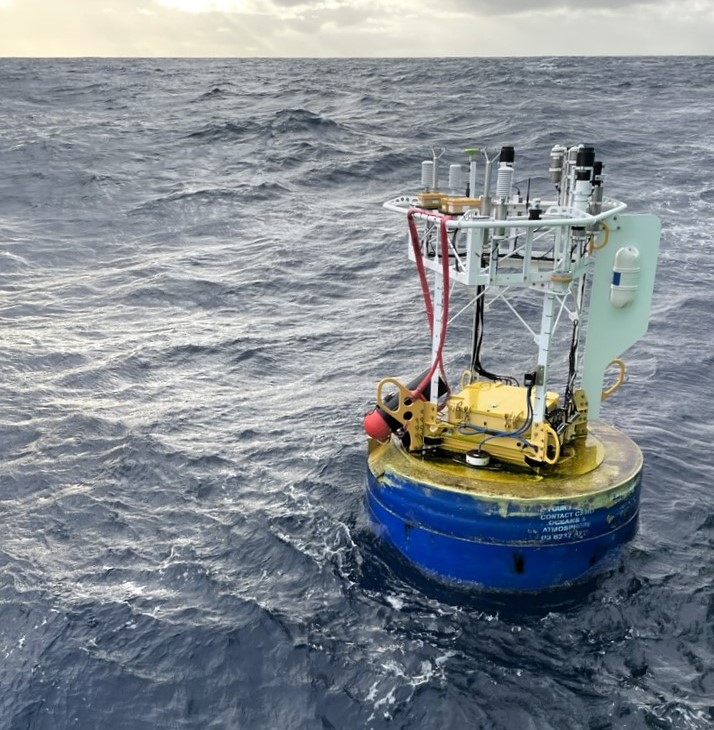Increasing atmospheric carbon amplifies seasonal CO2 cycle in Southern Ocean
27 October 2023
Using automated instruments moored in the Southern Ocean over the last decade, scientists have directly measured an increase in the magnitude of the ocean’s seasonal cycle of carbon dioxide for the first time.
The new study, published recently in Frontiers in Marine Science, used the sustained observations from the IMOS Southern Ocean Time Series (SOTS) site in the Subantarctic zone between 2011 and 2021 to evaluate the seasonality and trends in surface ocean CO2 partial pressure, or pCO2.
The surface ocean pCO2 is required to quantify the exchange of CO2 between the atmosphere and the ocean. Variations in the ocean pCO2 are caused by changes in temperature, ocean mixing, biological activity, and the concentration of CO2 in the atmosphere.
The Southern Ocean (south of 30°S) plays a crucial role in the global carbon cycle, responsible for about 40% of the total global ocean uptake of human-induced CO2 emissions, and 75% of the additional heat these emissions have trapped on Earth.

Lead author Dr Elizabeth Shadwick, a Principal Research Scientist at CSIRO and Co-Leader of the IMOS-SOTS facility, said the Subantarctic Zone (SAZ), roughly between the latitudes of 46° and 60° South, is a globally significant region for the uptake and storage of anthropogenic (human-induced) CO2 from the atmosphere.
“This amplification of the seasonal cycle has been expected due to the uptake of anthropogenic carbon, but these are the first direct Southern Ocean observations to quantify it,” Dr Shadwick said.
“Our research also found that the Subantarctic Zone is a net sink for atmospheric CO2 over the nearly 10-year record, with trends revealing that the ocean pCO2 may be increasing slightly faster than the atmosphere.”
The slightly faster increase in the surface ocean pCO2 (relative to the atmosphere) suggests that oceanic forcing, in addition to the uptake of anthropogenic CO2 from the atmosphere, may be contributing to the decadal change.
“The amplification of the seasonal cycle of surface ocean CO2 may additionally be driven by short term, local changes in ocean mixing and biological productivity,” Dr Shadwick said.
Understanding the changes in pCO2 seasonality is important for understanding the evolution of the Southern Ocean carbon sink, which has been the focus of many modelling studies given the scarcity of seasonally resolved observations.
“We are looking forward to our next voyage on CSIRO research vessel Investigator in 2024, which is essential for maintaining the IMOS moorings at this harsh and remote location in the Southern Ocean,” Dr Shadwick said.
“Sustaining this time series of Southern Ocean observations is crucial as we continue to untangle the processes behind the changes in pCO2 seasonality and the evolution of the Southern Ocean carbon sink.”
Leader of the Australian Antarctic Program Partnership, Prof Nathan Bindoff, said that distinguishing anthropogenic signals from natural variability in the Southern Ocean needs long-term observations sustained over many years.
“The Southern Ocean Time Series site southwest of Tasmania comprises two automated deep-water moorings including a sediment trap mooring, and an air-sea flux and biogeochemistry mooring.”
“With our partners, we regard the Southern Ocean Time Series as key Australian research infrastructure contributing to the international network of time series observatories, one of the few comprehensive Southern Ocean sites globally,” Prof Bindoff said.
The IMOS SOTS site is operated through a partnership between IMOS, CSIRO Marine National Facility, CSIRO, Bureau of Meteorology, and the Australian Antarctic Program Partnership (AAPP).
IMOS and the CSIRO Marine National Facility are national research infrastructure supported by the Australian Government’s National Collaborative Research Infrastructure Strategy (NCRIS).
Read the full paper:
Shadwick, EH, Wynn-Edwards, CA, Matear, RJ, Jansen P, Schulz, E, and Sutton AJ. 2023. Observed amplification of the seasonal CO2 cycle at the Southern Ocean Time Series. Front. Mar. Sci., 10| https://doi.org/10.3389/fmars.2023.1281854




